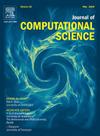Lattice Boltzmann simulation of pollutant transport in shallow water flows: Application to Nador lagoon
IF 3.7
3区 计算机科学
Q2 COMPUTER SCIENCE, INTERDISCIPLINARY APPLICATIONS
引用次数: 0
Abstract
This paper present a novel numerical method based on lattice Boltzmann and designed for simulating pollutant transport in Nador lagoon (Moroccan eastern coast of Mediterranean Sea). The model solves the shallow water equations coupled to the depth-averaged advection-diffusion equation. Solution of the Shallow water equations was performed by the multiple relaxation time lattice Boltzmann method, while the depth-averaged advection-diffusion equation was solved by the single relaxation time lattice Boltzmann method. To keep its role of mixing processes, the diffusion coefficients were determined by a linear relationship from the turbulent viscosity via the Schmit number. This relationship allowed the link of the relaxation time of hydrodynamics and the relaxation time of diffusion processes.
The results of the numerical hydrodynamic model were validated by comparison with laboratory measurements treating flow in two-branches channels. The analysis of this comparison showed that our numerical model reproduces this flow with high precision. Furthermore, the numerical solution of advection-diffusion equation was validated by comparison with both stationary and unsteady analytical solutions. The error analysis also showed that the proposed numerical model simulates the propagation of a contaminant with good accuracy.
After the validation phase, the numerical model was applied to simulate the propagation of pollutant for the real case of the Nador lagoon. For this case, the sources of pollution were identified at the positions of the different waterways bordering the southern shore of the lagoon. Two hydrodynamic scenarios were simulated: flow without wind and flow with wind. In the absence of measurement data on the area, the qualitative analysis of the simulation results showed consistency both with the literature on the study area and with the dynamics of the Eulerian circulation of the lagoon.
浅水流中污染物运移的晶格玻尔兹曼模拟:在纳多尔泻湖的应用
本文提出了一种基于晶格玻尔兹曼的模拟纳多尔泻湖(摩洛哥地中海东岸)污染物运移的数值方法。该模型求解了与深度平均平流扩散方程耦合的浅水方程。浅水方程采用多重松弛时间晶格玻尔兹曼方法求解,深度平均平流扩散方程采用单松弛时间晶格玻尔兹曼方法求解。为了保持其混合过程的作用,扩散系数由湍流粘度通过Schmit数确定为线性关系。这种关系使得流体力学的松弛时间与扩散过程的松弛时间相联系。数值水动力模型的计算结果与室内实测结果进行了验证。对比分析表明,我们的数值模型能较好地再现这种流动。通过与定常解析解和非定常解析解的比较,验证了平流扩散方程的数值解。误差分析还表明,所提出的数值模型能较好地模拟污染物的传播。在验证阶段后,应用数值模型对纳多尔泻湖的实际情况进行了污染物传播的模拟。在这种情况下,在与泻湖南岸接壤的不同水道的位置确定了污染源。模拟了两种流体力学情景:无风流动和有风流动。在缺乏该区域测量数据的情况下,对模拟结果进行定性分析,结果与研究区域的文献和泻湖欧拉环流的动态一致。
本文章由计算机程序翻译,如有差异,请以英文原文为准。
求助全文
约1分钟内获得全文
求助全文
来源期刊

Journal of Computational Science
COMPUTER SCIENCE, INTERDISCIPLINARY APPLICATIONS-COMPUTER SCIENCE, THEORY & METHODS
CiteScore
5.50
自引率
3.00%
发文量
227
审稿时长
41 days
期刊介绍:
Computational Science is a rapidly growing multi- and interdisciplinary field that uses advanced computing and data analysis to understand and solve complex problems. It has reached a level of predictive capability that now firmly complements the traditional pillars of experimentation and theory.
The recent advances in experimental techniques such as detectors, on-line sensor networks and high-resolution imaging techniques, have opened up new windows into physical and biological processes at many levels of detail. The resulting data explosion allows for detailed data driven modeling and simulation.
This new discipline in science combines computational thinking, modern computational methods, devices and collateral technologies to address problems far beyond the scope of traditional numerical methods.
Computational science typically unifies three distinct elements:
• Modeling, Algorithms and Simulations (e.g. numerical and non-numerical, discrete and continuous);
• Software developed to solve science (e.g., biological, physical, and social), engineering, medicine, and humanities problems;
• Computer and information science that develops and optimizes the advanced system hardware, software, networking, and data management components (e.g. problem solving environments).
 求助内容:
求助内容: 应助结果提醒方式:
应助结果提醒方式:


